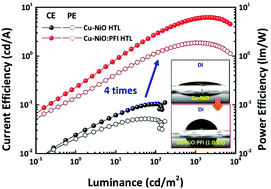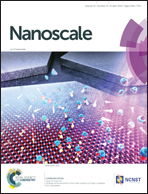Quantum-dot light-emitting diodes with a perfluorinated ionomer-doped copper-nickel oxide hole transporting layer†
Abstract
Herein, we report all solution-processed green quantum-dot light-emitting diodes (G-QLEDs) by introducing a perfluorinated ionomer (PFI, Nafion 117) into quantum dots (QDs) to improve hole injection. To reduce the energy level mismatch between the hole transporting layer (HTL) and QDs and exciton quenching on the metal–oxide surface, a PFI-mixed copper-doped nickel oxide (Cu-NiO) HTL was introduced for G-QLEDs. Mixing Cu-NiO with a PFI increases the work function and induces phase separation between Cu-NiO and PFI; thus, energy band bending occurs on the surface such that effective hole injection can be possible. The phase-separated PFI molecules on HTL affect the thickness and compactness of G-QDs and make a smooth interface between G-QDs and HTL. The G-QLED with a PFI and Cu-NiO mixture HTL exhibits the maximum current efficiency (CEmax), power efficiency (PEmax), and external quantum efficiency (EQEmax) of 7.3 cd A−1, 2.1 lm W−1, and 2.14%, respectively, which are about 4 times those of the QLED with a Cu-NiO HTL.



 Please wait while we load your content...
Please wait while we load your content...